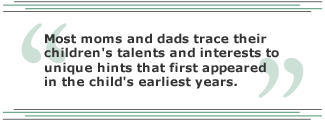Personnel managers often ignore a truth about human nature known to any mother who's had more than one kid: People are not the same.
Children of the same parents, raised in the same home, with the same rules and routines, emerge with dramatically different personalities. One is her own attorney, able to perfectly construct compelling arguments for buying a cell phone or going to a friend's party. Her brother is off the charts in math and able to retain everything in history class without taking a single note. Their younger brother is athletic and ambidextrous.
 |
Parents scratch their heads at the variety within their own offspring and conclude that each is "his own person" or "one of a kind." Most moms and dads trace their children's talents and interests to unique hints that first appeared in the child's earliest years.
Contrast these common observations with a strange piece of audio left on the CD "Yanni Live at the Acropolis." Standing at the center of the Herodian Amphitheater, surrounded by a full orchestra that had just finished playing one of his songs, John Yanni Christopher philosophizes: "Everything great that has ever happened to humanity has begun as a single thought in someone's mind. And if any one of us is capable of such a great thought, then all of us have the same capability, because we're all the same." The audience applauds loudly.
Choosing the right side of the argument is crucial for managers. If Yanni is right, companies shouldn't worry about matching the right person with the right job. Instead, they can invest heavily in molding people into the kinds of employees they need in specific roles. If Mom is right, all the re-education and incentives in the world won't make a numbers person into a wordsmith or convert an introvert into someone who excels in making cold calls.
A wealth of research says that Mom is right, and Yanni is wrong.
Doing what you do best
The ramifications of matching a person to what he or she naturally does best are so profound that this aspect of work life emerged as the Third Element of Great Managing, one of 12 elements that best predict the performance of an employee or team. This element is measured by one's intensity of agreeing with the statement, "At work, I have the opportunity to do what I do best every day." (See sidebar "The 12 Elements of Great Managing.)
In many circles today, the idea that a person has a unique combination of talents may seem like common sense. But for many decades, the opposite view held sway in psychology, and vestiges of these discredited theories lie at the heart of human resources strategies in some companies.
Although he may not realize it, Yanni's opinion of human potential has its roots in a psychological approach called behaviorism, which was accepted wisdom from the early to mid 1900s. Its chief proponents argued that an individual's personality is simply the sum of adaptations he made to match his environment. Under this theory, people are infinitely malleable, each a collection of Pavlovian drooling responses to the world's dinner bells. "Give me a dozen healthy infants, well formed, and my own specified world to bring them up in, and I'll guarantee to take any one at random and train him to become any type of specialist I might select -- doctor, lawyer, merchant-chief, and yes, even beggar-man and thief, regardless of his talents, penchants, tendencies, abilities, vocations, and race of his ancestors," wrote American psychologist John B. Watson.
More frequently than one might imagine, companies hesitate to put too much emphasis on any one person's abilities or accomplishments for fear others will feel hurt or left out. "There's a lot of 'Harrison Bergeron' thinking around here," one personnel executive confides, referring to the 1961 short story by Kurt Vonnegut that begins: "The year was 2081, and everyone was finally equal." The story describes a future in which government "handicappers" snuff out all forms of exceptional performance. "Nobody was any smarter than anyone else," it says. "Nobody was better looking than anybody else. Nobody was stronger or quicker than anybody else."
But people are different. We certainly recognize it in sports, where the physical differences that correlate with success can't be ignored. Basketball players must practice for years to refine their games, condition their bodies to perform, and train their reflexes to hit a three-point jump shot. Yet none of this is sufficient by itself to make it into the National Basketball Association, where the average player is over 6-foot-7, compared with the average American man's height of 5-foot-9½. Does anyone doubt that, in addition to years of coaching and practice, Houston Rockets' star Yao Ming owes much of his success to being 7 feet, 6 inches tall?
"You can't coach height," says the old bromide. Pro basketball players are first born, then made.
Einstein's brain
A growing accumulation of evidence indicates that in their functioning, brains are just as variable as bodies. There are even tantalizing hints of anatomical differences in the brains of those with extraordinary mental abilities. The most famous example is that of Albert Einstein. After the physicist died in 1955, his brain was removed, measured, and preserved. In 1999, three scientists from McMaster University in Canada compared Einstein's brain to the university's collection of "normal brains" donated for research.
 |
Einstein described his scientific thinking as not using words, but rather "associative play" of "more or less clear images" of a "visual and muscular type." Because of Einstein's abilities and his own description of his thinking, the professors paid special attention to his left and right posterior parietal regions, responsible for "visuospatial cognition, mathematical ideation, and imagery of movement."
Einstein's brain had unique attributes not seen in any of those in the McMaster collection "nor in any specimen documented in the published collections of post-mortem brains," the professors wrote in the British medical journal The Lancet. "Einstein's exceptional intellect in these cognitive domains and his self-described mode of scientific thinking may be related to the atypical anatomy in his inferior parietal lobes."
Extrapolating to the population in general, the scientists hypothesized: "Variation in specific cognitive functions may be associated with the structure of the brain regions mediating those functions." The implications are incredible. Because of real physical differences in the brain, a person might be to accounting what Yao Ming is to basketball, to marketing what Mickey Mantle was to baseball, or to corporate creativity what Pelé was to soccer -- an employee's brain structure could give him or her an advantage over others in the same way physical stature gives an edge to the champion athlete.
Just like our physical characteristics, our talents are unique. And, a personnel strategy based on talents creates concrete financial advantages. Several years ago, Â鶹´«Ã½AV analyzed 2,000 managers' responses to open-ended questions about their management approaches. Of particular interest was whether the supervisor believed it was better to devote more of his or her energy to "fixing" people's weaknesses or to further improving an area of strength.
When the interview responses were compared with performance data for their teams, it turned out that the managers of the best workgroups were more likely to spend a disproportionate amount of time with their high producers, match talents to tasks, and emphasize individual strengths over seniority in making personnel decisions. On average, a workgroup led by a strengths advocate was almost twice as likely to create above-average results as one led by a manager biased toward patching up problems.
 |
A recent study found that organizations that focused on maximizing the natural talents of their employees increased engagement levels by an average of 33% per year, equating to an average net gain of $5.4 million in productivity per organization over enterprises using more traditional methods. Another recent study found that sales representatives who received feedback on their strengths sold 11% more than those who did not receive such feedback.
The Third Element is powerful in explaining not only productivity, but also the future profitability of teams within companies. Business units in the top quartile of Â鶹´«Ã½AV's database on the "do what I do best" statement exceed the profits of those in the bottom quartile by an average of 10% to 15%. A recent analysis of multiple studies reveals that managers whose talents are aligned with their job demands achieve, on average, 15% more in sales and 20% more in profit, have 24% fewer unscheduled absences, and deal with 13% lower employee turnover than the average.
For all the evidence that this approach is good for business, only about one in three employees can strongly agree that they "have the opportunity to do what they do best every day." The amount of money left on the table is staggering. Businesses agonize over marketing plans, inventory strategies, labor models, and new product introductions in search of one or two more points of profit. Few of them realize part of the answer is so close to home. They should have listened to their mothers.
